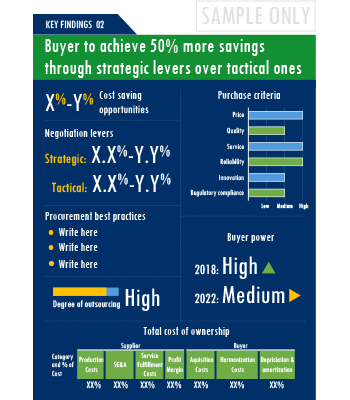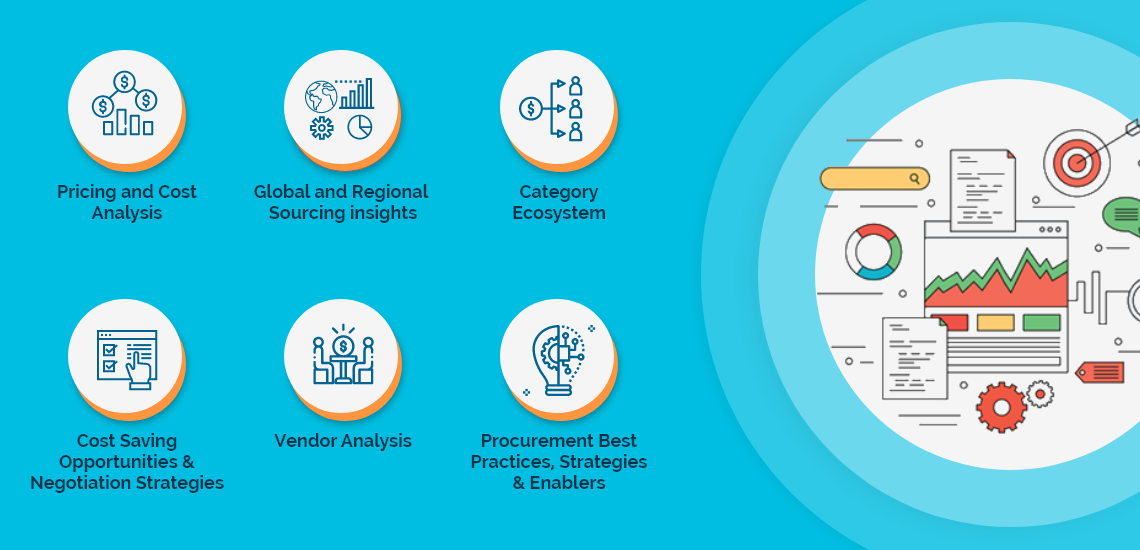A purchasing guide for Dust Monitoring – rich advisory on spend outlook in Dust Monitoring, pricing analysis for Dust Monitoring procurement cost benchmarking, negotiation strategies and key vendors of Dust Monitoring.
GET FREE SAMPLEThis report on global Dust Monitoring category is part of a larger series of reports on global Environmental Services market. The scope of Environmental Services spans multiple categories and is typically identified as a procurement category that includes all spend within the environment including animal and agriculture related services. The service should be procured and used to fill a skills gap for the defined subject areas where the service requirement includes delivery or implementation. Materials and consultancy not part of the category, unless the contract specifically provides for their inclusion.
A changing ecosystem within the Environmental Services market also affects the procurement process, cost dynamics and supplier attractiveness for the buyers of Dust Monitoring. Suppliers are increasingly offering a 'bundle' of services which is marketed as a cost saving option. The bundled offering often includes services that are not required by the buyer or are charged at a much higher rate than an A la carte option with another supplier.Many suppliers are investing in automation technologies such as AI, robotics, machine learning and big data to optimize their business operations and offer new services to their customers. However, a part of this investment is also passed to buyers in the form of high prices being charged for value added services.New locations and vendors are emerging as cost effective suppliers of Dust Monitoring, offering an opportunity to widen the supplier base and gain further negotiation leverage with incumbent suppliers.
As market conditions become more dynamic and procurement practices get more sophisticated, category managers need to be cognizant of the best practices that work for their Dust Monitoring category procurement. The report offers a succinct analysis of Dust Monitoring procurement best practices. For example, Category managers must ensure that they have clearly identified and listed down potential negotiation levers to maximize the value of their category spend before entering into contract-related discussions with service providers. Common negotiation levers to maximize value include deadlines, terms related to payments, (including fees, expenses, and payment timelines) and assistance required from the buyer's organization. Buyers should set a baseline against which the performance of suppliers can be benchmarked along with setting measurable/quantifiable KPIs. Defined KPIs provides suppliers with clarity on the scope. Besides setting standards for operations, pricing, and performance, KPIs must provide tangible goals in terms of the quality of solutions. Cost saving opportunities may reduce exponentially in relation to the time left for current contract to expire or required timeline to start the engagement. Therefore sufficient interval should exist between initation of new procurement and expected start date of the new contract for Dust Monitoring.
Activate your free account to gain easy access to cutting edge research and insights on consumers, emerging price trends, global and regional suppliers.
Dust Monitoring procurement managers also need to proactively identify and mitigate potential risks that can arise in the supply chain or contracts for Dust Monitoring procurement. Some examples include:
For detailed insights and complete access to our report library, activate your free account!
The report is intended to serve as a one-stop reference guide for Dust Monitoring procurement strategy and offers a perfect blend of category basics with deep-dive category data and insights. Therefore, it is ideal for category beginners looking for “Dust Monitoring: Procurement Report 101” as well as for category experts actively tracking the global Dust Monitoring procurement market.
You may have just initiated your research to design a winning Dust Monitoring procurement strategy, or you may be a category expert looking for strategic insights and updated data.Either ways, the report has your requirements covered.

Unlock SpendEdge's comprehensive procurement report collection with ease through our procurement platform.
Procurement decisions can prove to be costly in the absence of careful deliberation and evaluation of every available option. In fact, more than 90% of the decision makers we work with acknowledge that timely availability of up-to-date category intelligence can help them make better purchasing decisions. More than 80% of them believe that in-house category intelligence needs to be updated periodically to achieve full benefits. If you have read so far, we are quite sure you agree!!
The Dust Monitoring procurement report helps take more informed decisions by placing all the critical information and advice at the fingertips of a decision maker. It also specifically answers some of the key questions that we have been routinely asked during our industry outreach initiatives:
SpendEdge Insights has helped procurement professionals and sourcing teams manage multiple spend areas and achieve more than $2 billion in savings. Activate your free account today!
The Dust Monitoring market report offers a complete picture of the supply market and analyzes the category from the perspective of both buyers and suppliers. Analysis of the category trends, procurement best practices, negotiation levers and overall category management strategy advisory are interspersed with in-depth data and commentary on spend outlook, pricing ecosystem and supplier landscape drilled down to a region-level coverage.

A key highlight of this report is the in-depth outlook created on Dust Monitoring procurement spend and pricing trends. The report further delves deep into the aspects of cost structure, total cost of ownership and supplier margins for Dust Monitoring. A dedicated section to supplier profiles and evaluation helps decision makers cast a wider procurement net and identify gaps in existing relationships.

Along with specific category and supplier intelligence, the publication also includes curated insights on Dust Monitoring market trends, price influencers and inherent risks. These insights help the decision makers prepare for market shaping trends in advance and create alternative strategies for changes in the market conditions.

Additionally, the report also advises on the best practices and strategies to manage the Dust Monitoring category efficiently. Negotiation levers and opportunities are explained in detail along with quantification of their potential. Benchmark KPIs for supplier and buyer performance management are also aggregated to better organize the category objectives. Other themes of advisory include ideal procurement organization structure, enablers to achieve KPIs or category objectives and ideal SLAs to have with suppliers.






Our research is complex, but our reports are easy to digest. Quantitative analysis and exhaustive commentary is placed in an easy to read format that gives you an in-depth knowledge on the category without spending hours to figure out “what does it mean for my company?”


SpendEdge presents a detailed picture of Dust Monitoring procurement solutions by way of study, synthesis, and summation of data from multiple sources. The analysts have presented the various facets of the market with a particular focus on identifying the key category influencers. The data thus presented is comprehensive, reliable, and the result of extensive research, both primary and secondary.

Global Asbestos Removal And Management Market - Procurement Intelligence Report

Global Bulk Heap Dust Suppression Market - Procurement Intelligence Report

Global Decommissioning, Remediation and Restoration Services Market - Procurement Intelligence Report

Global Lead Paint Removal And Management Market - Procurement Intelligence Report

Global Soil And Groundwater Remediation Market - Procurement Intelligence Report

Global Environmental Planning Services Market - Procurement Intelligence Report

Global Mold Removal And Management Market - Procurement Intelligence Report

Global Environmental Remediation Services Market - Procurement Intelligence Report

Global Dust Suppression Services For Material Transfer Market - Procurement Intelligence Report
Access this report and our entire procurement platform | Plans starting from USD 3000/ Year Buy Now
Copyright © 2024 Infiniti Research Limited. All Rights Reserved. Privacy Notice – Terms of Use – Sales and Subscription
Cookie Policy
The Site uses cookies to record users' preferences in relation to the functionality of accessibility. We, our Affiliates, and our Vendors may store and access cookies on a device, and process personal data including unique identifiers sent by a device, to personalise content, tailor, and report on advertising and to analyse our traffic. By clicking “I’m fine with this”, you are allowing the use of these cookies. You may change your settings based on a legitimate interest at any time, by selecting “Manage Settings” on our site. Please refer to the help guide of your browser for further information on cookies, including how to disable them. Review our Privacy & Cookie Notice.
